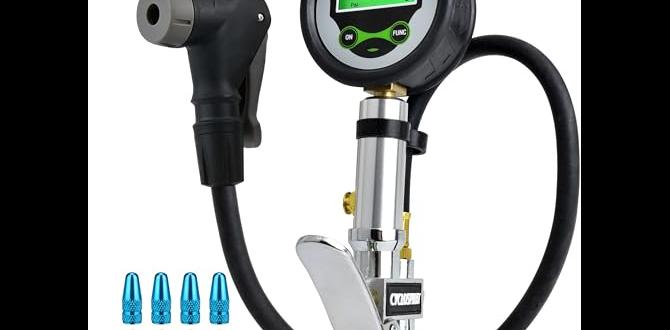Quick Summary:
Get a proven, easy setup for your dual battery switch wiring diagram. This guide simplifies the process, helping you connect two batteries reliably for marine, RV, or off-grid power. Learn the basics and install your system confidently, ensuring consistent power.
Wiring Diagram for Dual Battery Switch: Proven Easy Setup
Ever found yourself struggling with a dead battery when you need power most? It’s a common headache, especially if you rely on a robust power system for your boat, RV, or off-grid adventures. Thankfully, a dual battery switch can be your best friend, letting you manage two batteries for reliable, continuous power. But when it’s time to wire things up, it can feel a bit daunting. Don’t worry! This guide is here to break down the wiring diagram for a dual battery switch into simple, easy steps. We’ll walk you through the process, making sure you can set up your dual battery system with confidence.
You’ll learn exactly what components you need, how they connect, and why this setup is so effective. By the end, you’ll have a clear picture of how to wire your dual battery switch for dependable power, no matter where you are.
Why a Dual Battery Switch?
Installing a dual battery switch system is a smart move for anyone who needs reliable and flexible power. Imagine this: your main battery powers your everyday needs, like starting your engine and running essential electronics. Your second battery acts as a backup or is dedicated to powering heavier loads, like your trolling motor, RV appliances, or off-grid systems. A dual battery switch lets you choose which battery is connected to your loads, or even connect both together. This means you can:
- Prevent a Dead Main Battery: Keep your primary battery ready to start your engine by isolating it from constant draws.
- Maximize Usable Power: Get the most out of both your batteries without worrying about draining the wrong one.
- Simplify Power Management: Easily switch between batteries or combine them with a simple turn of a dial.
- Protect Your Investment: Extend the life of your batteries by preventing deep discharge on your starting battery.
Understanding the Core Components
Before we dive into the wiring diagram, let’s look at the key players in your dual battery setup. Knowing what each part does will make the wiring process much clearer.
1. The Dual Battery Switch (Selector Switch)
This is the heart of your system. It’s a heavy-duty switch that allows you to select which battery is connected to your boat’s or RV’s electrical system. They come in various configurations, but the most common for a simple dual battery setup is a 1/2/Both/Off switch.
- 1: Connects only Battery 1 to the system.
- 2: Connects only Battery 2 to the system.
- Both: Connects both Battery 1 and Battery 2 in parallel to the system. This is often used for charging or providing maximum power.
- Off: Disconnects both batteries from the system. Essential for safety during maintenance or when storing your vehicle/vessel.
2. Batteries (Battery 1 and Battery 2)
You’ll need two batteries. They don’t necessarily have to be identical, but it’s generally recommended for longevity and performance. One is often your primary starting battery, and the second can be a deep-cycle battery designed for prolonged discharge (like for trolling motors or RV house loads).
3. Battery Cables
These are thick, flexible wires that carry the electrical current. You’ll need several of different lengths to connect your batteries to the switch and then the switch to your main electrical distribution point (like a bus bar or your starter motor/inverter).
4. Bus Bars (Optional but Recommended)
A bus bar is a metal strip with multiple terminals. It acts as a central point to connect multiple wires together, keeping your wiring neat and organized. You’ll typically need one for the positive connections and one for the negative.
5. Fuses or Circuit Breakers
Safety first! In-line fuses or circuit breakers are crucial to protect your wiring and equipment from overcurrents or short circuits. The size of the fuse depends on the total amperage your system can draw and the wire gauge you’re using. Always consult fuse manufacturer guidelines and your system’s requirements.
6. Terminals and Connectors
Ring terminals are typically used to connect cables to battery posts and switches. Heat shrink tubing helps to insulate connections and prevent corrosion.
The Basic Dual Battery Wiring Diagram Explained
Let’s break down the most common and straightforward setup for a dual battery switch. This is often called a “single-pole, double-throw” configuration when you consider the basic function of directing current. We’ll focus on connecting two batteries to a single switch that then feeds your main electrical loads.
Understanding the Connections
The core idea is simple: each battery connects to its own set of terminals on the switch. From the switch, all selected output terminals are merged to feed your boat’s or RV’s electrical system. The negative side is usually simpler, connecting both battery negatives to a common ground.
Wiring Diagram Visualization
Imagine looking at the back of your dual battery switch. It will typically have several terminals: two for each battery (positive and sometimes negative, depending on the switch type), and one or more output terminals that go to your electrical system. Some switches have separate terminals for Battery 1 input, Battery 2 input, and a combined output. Others might have terminals for Battery 1, Battery 2, and a common output to the load.
For a typical 1/2/Both/Off switch, you’ll find terminals labeled for:
- Battery 1 Positive
- Battery 2 Positive
- Battery 1 Negative (or a common negative terminal)
- Battery 2 Negative (or a common negative terminal)
- Output Positive (to your loads)
In the simplest setup, the switch handles the positive connections, and the negatives of both batteries are connected directly to your boat’s or RV’s main negative ground bus bar. This simplifies wiring and ensures a common ground for all components.
Step-by-Step Installation Guide
Here’s how to wire up your dual battery switch system. Safety is paramount, so always disconnect all power sources and wear safety glasses. If you’re uncomfortable at any point, consult a marine electrician or qualified technician.
Tools and Materials You’ll Need:
- Dual Battery Switch (1/2/Both/Off type)
- Two Marine-Grade Batteries
- Heavy-gauge Battery Cables (appropriate length and gauge for your system’s amperage)
- Ring Terminals (sized for your battery posts and switch terminals)
- Heat Shrink Tubing
- Wire Strippers/Crimpers
- Wrench or Socket Set (for battery terminals and switch)
- Multimeter (for testing)
- Safety Glasses
- Gloves
Step 1: Plan Your Layout
Decide where your batteries and switch will be mounted. Ensure they are in a dry, well-ventilated area, secured properly, and accessible. The switch should be within easy reach of the helm or control area.
Step 2: Prepare the Battery Cables
You’ll need three main cables for the positive side:
- Cable A: Battery 1 Positive Terminal to the Battery 1 lug on the switch.
- Cable B: Battery 2 Positive Terminal to the Battery 2 lug on the switch.
- Cable C: Output lug on the switch to the positive side of your main electrical distribution (often a positive bus bar or directly to your main fuse panel/starter).
For the negative side:
- Cable D: Battery 1 Negative Terminal to your main negative bus bar.
- Cable E: Battery 2 Negative Terminal to your main negative bus bar.
Important Note on Cable Gauge: The gauge of your cables is critical and depends on the total current your system will handle and the length of the cable. Undersized cables can overheat, cause voltage drops, and be a fire hazard. It’s best to use a marine-grade cable, typically rated for 50V or 100V DC. You can consult charts from reputable suppliers like Blue Sea Systems for correct sizing based on amperage and distance: Marine Wire and Cable Sizing Charts.
Step 3: Connect the Batteries to the Switch (Positive)
- Install a ring terminal on one end of Cable A. Ensure it’s a tight crimp and protected with heat shrink.
- Connect this terminal to the positive (+) post of Battery 1.
- Connect the other end of Cable A to the “Battery 1” or “Pos 1” terminal screw on your dual battery switch. Tighten securely.
- Repeat steps 1-3 for Cable B and Battery 2, connecting it to the “Battery 2” or “Pos 2” terminal on the switch.
Step 4: Connect the Switch Output (Positive)
- Install a ring terminal on one end of Cable C.
- Connect this terminal to the “Output” or “Load” terminal on your dual battery switch. Tighten securely.
- Connect the other end of Cable C to the positive (+) terminal of your main electrical distribution point (e.g., a positive bus bar, main fuse block, or starter solenoid).
Step 5: Connect the Battery Negatives
This is where you establish a common ground.
- Install a ring terminal on one end of Cable D.
- Connect this terminal to the negative (-) post of Battery 1.
- Connect the other end of Cable D to your main negative bus bar. Tighten securely.
- Repeat steps 1-3 for Cable E, Battery 2, and the negative bus bar. Each battery’s negative terminal should connect directly to the common ground.
Step 6: Install Fuses or Circuit Breakers
Safety is critical. For a basic setup, you’ll typically want a main fuse or circuit breaker on the positive output cable from the switch (where Cable C connects to your distribution panel). The rating should be appropriate for your system’s total expected load.
Some installers also prefer to place a fuse or breaker between the batteries and the switch on each individual battery cable (Cable A and Cable B) if the switch itself doesn’t offer primary protection.
Step 7: Test Your Setup
- Double-check all connections. Ensure all terminals are tight and no stray wire strands are causing shorts.
- Turn the dual battery switch to the “OFF” position.
- If you have a multimeter, check the voltage at the terminals where your batteries will connect to the switch. Confirm correct polarity.
- Carefully connect the batteries.
- Turn the switch to “1”. Use your multimeter to check for voltage at your electrical distribution panel. It should read the voltage of Battery 1.
- Turn the switch to “2”. Check voltage again. It should read the voltage of Battery 2.
- Turn the switch to “Both”. Check voltage. It should be slightly higher than individual battery voltages (due to parallel connection) and stable.
- Test a few of your essential electrical loads to ensure they are functioning correctly in each switch position.
Advanced Considerations and Variations
While the above covers the most common beginner setup, there are variations and upgrades to consider as your needs evolve.
Battery Charging
With a simple 1/2/Both switch, you can charge both batteries when the switch is in the “Both” position. This connects them in parallel, so your alternator or shore power charger will charge both simultaneously. However, this also means if one battery is significantly weaker, it can drag down the charge rate for the stronger one.
For more sophisticated charging (e.g., different battery types or smarter charging), you might consider:
- Battery Isolators: These use diodes to allow current from the alternator to flow to both batteries but prevent current from flowing between them when the alternator isn’t running. This is great for charging but doesn’t offer the switching selection for loads.
- DC-to-DC Chargers: These regulate voltage and current specifically for your battery banks, ideal for mixed battery chemistries (like lead-acid and lithium).
- Smart Battery Switches/Combiners: Some advanced switches automatically connect batteries when they detect sufficient charging voltage from the alternator and disconnect them when voltage drops.
Wiring Diagram for a 4-Position Switch (e.g., 1/2/Both/Off with some variations)
Most basic dual battery switches are the 4-position type (1, 2, Both, Off). The diagram and steps above apply directly to these.
Wiring a 3-Position Switch (e.g., 1/2/Off)
Some simpler switches might omit the “Both” position. The wiring is similar, but you won’t have the option to combine batteries. This is often sufficient if your primary goal is simply to isolate a starting battery from a house battery.
High-Amperage Systems and Cable Sizing
For larger boats, RVs, or off-grid systems with high power demands (e.g., multiple inverters, large appliances), proper cable sizing is absolutely critical. Undersized cables are a major safety hazard and can lead to significant voltage drop, reducing the performance of your equipment.
A popular resource for understanding cable sizing for marine applications (which is often applicable to RVs and off-grid DC systems) is by Blue Sea Systems. They provide detailed tables and calculators. Adhering to recommended standards, such as those found in the ABYC (American Boat and Yacht Council) standards for cable sizing, is highly recommended. You can often find these standards referenced by reputable marine electrical suppliers. For example, iBoats provides a good overview of cable sizing principles relevant to DC systems.
General Rule of Thumb for DC Cable Sizing (Amperage & Distance is key):
The two most important factors are the maximum amperage the cable will carry and the total length of the cable run (from battery to switch to load, and back to ground). A common target for voltage drop in DC systems is no more than 3% for critical circuits (like starting) and 10% for non-critical circuits.
| Amperage (Max Continuous) | Approximate Wire Gauge (AWG) for 5-15ft Run | Approximate Wire Gauge (AWG) for 15-25ft Run |
|---|---|---|
| 50A | 8 AWG | 6 AWG |
| 100A | 6 AWG | 4 AWG |
| 150A | 4 AWG | 2 AWG |
| 200A | 2 AWG | 0 AWG |
(Note: This table is a simplified guide. Always refer to official sizing charts based on your specific vessel/vehicle and local electrical codes (e.g., ABYC, NEC) for precise requirements.)
Using Bus Bars for a Cleaner Setup
When you have multiple loads or need to connect several negative wires, a bus bar makes things much tidier. You’ll typically install one positive bus bar and one negative bus bar.
- Positive Bus Bar: The output of your dual battery switch connects to the main input terminal of the positive bus bar. Then, individual positive wires for your various loads (lights, pumps, electronics) connect to the other terminals on the bus bar.
- Negative Bus Bar: All the individual negative wires from your loads connect to the negative bus bar. The negative terminals of both batteries also connect directly to this negative bus bar, completing the common ground.
This centralizes connections, minimizes wire routing, and makes troubleshooting easier. Most marine and RV component manufacturers, like Blue Sea Systems, offer high-quality bus bars.
Safety First! Essential Precautions
Working with car batteries and electrical systems carries risks. Always prioritize safety.
- Disconnect Power: ALWAYS disconnect the negative terminal of any battery before beginning work. Then, disconnect the positive.
- Wear Safety Gear: Always wear safety glasses to protect your eyes from sparks or acid. Gloves can protect your hands.
- Ventilation: Batteries can emit flammable hydrogen



